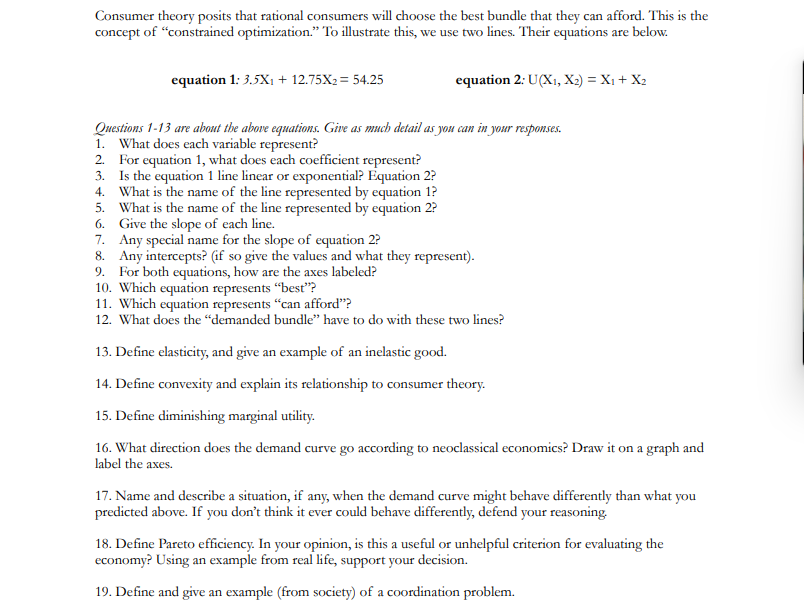
Consumer theory posits that rational consumers will choose the best bundle that they can afford. This is the concept of "constrained optimization." To illustrate this, we use two lines. Their equations are below. equation 1:3.5 X1+12.75X2=54.25 equation 2: U(X1,X2)=X1+X2 Questions 1-13 are about the above equations. Give as mucb detail as you can in your responses. 1. What does each variable represent? 2. For equation 1, what does each coefficient represent? 3. Is the equation 1 line linear or exponential? Equation 2? 4. What is the name of the line represented by equation 1 ? 5. What is the name of the line represented by equation 2 ? 6. Give the slope of each line. 7. Any special name for the slope of equation 2? 8. Any intercepts? (if so give the values and what they represent). 9. For both equations, how are the axes labeled? 10. Which equation represents "best"? 11. Which equation represents "can afford"? 12. What does the "demanded bundle" have to do with these two lines? 13. Define elasticity, and give an example of an inelastic good. 14. Define convexity and explain its relationship to consumer theory. 15. Define diminishing marginal utility. 16. What direction does the demand curve go according to neoclassical economics? Draw it on a graph and label the axes. 17. Name and describe a situation, if any, when the demand curve might behave differently than what you predicted above. If you don't think it ever could behave differently, defend your reasoning. 18. Define Pareto efficiency. In your opinion, is this a useful or unhelpful criterion for evaluating the economy? Using an example from real life, support your decision. 19. Define and give an example (from society) of a coordination problem. Consumer theory posits that rational consumers will choose the best bundle that they can afford. This is the concept of "constrained optimization." To illustrate this, we use two lines. Their equations are below. equation 1:3.5 X1+12.75X2=54.25 equation 2: U(X1,X2)=X1+X2 Questions 1-13 are about the above equations. Give as mucb detail as you can in your responses. 1. What does each variable represent? 2. For equation 1, what does each coefficient represent? 3. Is the equation 1 line linear or exponential? Equation 2? 4. What is the name of the line represented by equation 1 ? 5. What is the name of the line represented by equation 2 ? 6. Give the slope of each line. 7. Any special name for the slope of equation 2? 8. Any intercepts? (if so give the values and what they represent). 9. For both equations, how are the axes labeled? 10. Which equation represents "best"? 11. Which equation represents "can afford"? 12. What does the "demanded bundle" have to do with these two lines? 13. Define elasticity, and give an example of an inelastic good. 14. Define convexity and explain its relationship to consumer theory. 15. Define diminishing marginal utility. 16. What direction does the demand curve go according to neoclassical economics? Draw it on a graph and label the axes. 17. Name and describe a situation, if any, when the demand curve might behave differently than what you predicted above. If you don't think it ever could behave differently, defend your reasoning. 18. Define Pareto efficiency. In your opinion, is this a useful or unhelpful criterion for evaluating the economy? Using an example from real life, support your decision. 19. Define and give an example (from society) of a coordination







